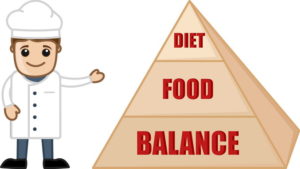The human body uses carbohydrates as the primary source of energy and uses glucose to fulfill the levels of energy needed for its everyday functioning. However, it doesn’t mean other macronutrients such as proteins and fats can’t be used to realize this energy that the body needs.
In the case of glucose (produced when carbohydrates are digested in the body) deprivation, the body will resort to consuming fat as the main energy source. This metabolic process burns fat and results in the accumulation of carbonyl group organic compounds in the body called ketones.
Even though ketosis is a regular metabolic process within the human body, it has become popular among people in recent years due to a weight loss diet that is based on the natural feature of human metabolism.
What is Ketogenic Diet?
More commonly known as the keto diet or low carb diet, is the one in which a person intentionally limits his or her’s consumption of carbohydrate-based foods to very minimal levels and replaces them with fat-based meals. This change in the dieting pattern directs the body in the metabolic state of ketosis. When the body is only available with fats to burn to get adequate energy, it becomes significantly efficient in burning fat. This change in the metabolic process can result in various health implications that are most beneficial in nature. In other words, by reducing carbohydrate intake, more fat will be converted into energy.
Classifications of Ketogenic Diets
Not all individuals should partake in a Ketogenic Diet, but if you decide to, speak to your doctor first. Then if you are given the green light, determine which category of these diets would be best for you.
There are several variants of the ketogenic diet adopted by people according to the result they want from. The classifications are based on the proportion of intake of three major macronutrients.
Standard Ketogenic Diet
Standard Ketogenic Diet (SKD) is the most prevalent version and most of the people who go with this diet follow SKD to lose weight. SKD diet plans are rich in fats, with moderate consumption of proteins and very low carbohydrate intake. The proportion usually goes as:
- 75% fats
- 20% proteins
- 5% carbohydrates
Cyclical Ketogenic Diet
As its name suggests, this diet has cyclic patterns where the number of carbs in the diet is increased temporarily in a periodic manner. Usually, a week is divided into five ketogenic days and two high carb days.
Targeted Ketogenic Diet
In this pattern, carbs are usually consumed around workout sessions. People who are involved in bodybuilding exercises usually follow this diet.
High-Protein Ketogenic Diet
It is the same as the standard ketogenic diet, but with more portions of protein-based foods in the plan. The amount of protein intake goes to 30% in this keto diet.
Ketogenic Diets: How Healthy are They?
Ketogenic diets have several proven health benefits. We all know it is popular for its ability to bring on a significant weight loss in a person. For instance, it has proven to have better weight loss results than a low-fat diet. It is also effective because unlike calorie-restricted diets, you don’t have to exhaust yourself in counting the calories of consumed foods all the time.
A Simple Design
The weight-loss method is very simple in ketogenic diets. The body becomes efficient in burning and consuming fats which helps in reducing the weight by burning up the excessive adipose tissues. Decreased glucose levels in the blood due to decreased consumption of carbs and decreased insulin resistance also assist the weight loss process.
Beneficial for Type 2 Diabetes Patients
Type 2 diabetes entails changes in metabolism where body sugar levels always remain high with declined insulin activity. A research study has found out that only adopting a ketogenic diet by type 2 diabetic patients can reduce their medication intake. Out of 21 participants in the study, 7 were succeeded in controlling their blood glucose level without the help of any diabetes prescription.
May Help with Bipolar Disorder
A preliminary study suggests that a low-carb diet may be advantageous to persons suffering from bipolar disorder, as they maintain higher sodium inside their bodies than people who do not have this illness. One of the functions of the medications used to maintain mood stabilization is to lower the individual’s sodium levels. By default, ketogenic diets also lower sodium levels.
Additional studies performed also suggest that people with epilepsy may benefit from this diet.
Possible Side Effects
Due to a radical change in the eating pattern, one might experience an upset digestive system through diarrhea, constipation, nausea or vomiting.
Ketogenic diets can also result in temporary fatigue in the transition period during which the body is setting and adjusting itself in a newly developed ketosis-influenced environment.
In addition, ketogenic diets are very particular and consequently, deficiencies of vitamins B, C, and D, as well as calcium, magnesium and iron could result. These deficiencies may continue the cycle of the digestive issues mentioned above. Sometimes, but rarely, abnormal heart rhythms, pancreatitis, weakened bones and kidney stones may develop.
Be sure to speak to a medical professional before starting any diets!
How Do I Start?
Provided you got the proper clearance from your doctor or medical professional, you can start here. Another method would be to contact a nutritionist or other expert in dieting and begin with them.
REMEMBER: BE SURE TO ALWAYS CONSULT WITH YOUR MEDICAL PROFESSIONAL BEFORE TRYING STARTING OF THESE DIETS!


